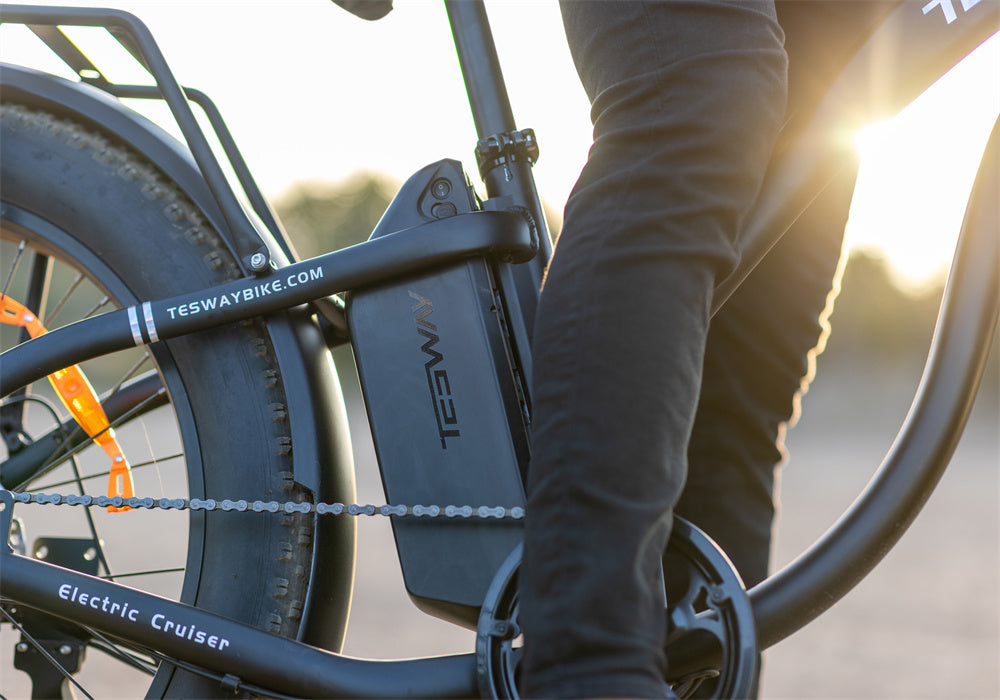Proper care and maintenance of your electric bike battery can significantly enhance its lifespan, ensuring you get the most out of every charge.
In this comprehensive guide, we will provide you with five essential tips for eBike battery care and strategies to extend the life of your E-Bike battery.
Proper Charging Practices
To extend the life of your ebike battery, it’s essential to follow proper charging practices.
Charging the battery correctly can prevent premature wear and maintain its capacity over time.
Always disconnect the battery once it reaches 100% charge. Overcharging can cause overheating and reduce battery life.
Modern chargers often have auto-shutoff features, but it’s still good practice to unplug promptly.
For regular use, charging your battery to around 80% can significantly extend its lifespan.
This practice reduces the stress on the battery cells and prevents overexertion.
Avoid letting the battery drop to 0% frequently. Deep discharges can strain the battery and shorten its life.
Instead, aim to recharge when the battery is around 20-30%. Charge your eBike battery in a cool, dry place.
Extreme temperatures, whether hot or cold, can negatively impact the battery's performance and longevity.
SEE ALSO Don't Do It | Charging an e-bike from another e-bike battery is risky!
Optimal Storage Conditions
How you store your eBike battery when not in use can greatly influence its longevity.
Proper storage conditions are crucial for maintaining battery health. Store the battery in a location that is cool and dry, away from direct sunlight and extreme temperatures.
Ideal storage temperatures range between 10°C to 20°C (50°F to 68°F). If you plan to store your eBike battery for an extended period, keep it at a partial charge (around 50-60%).
This helps maintain the battery's health and readiness for use. If stored for long periods, check the battery charge level every few months and recharge to 50-60% if necessary.
This practice ensures the battery remains in good condition during storage.
Never store your battery completely discharged.
This state can lead to cell degradation and may render the battery unusable.
Routine Maintenance
Routine maintenance of your electric bike battery can prevent potential issues and ensure optimal performance.
Regular care and inspection are key to extending battery life. Periodically clean the battery contacts and terminals with a dry cloth.
Dirt and corrosion can impede the connection between the battery and the bike, affecting performance.
Inspect the battery for any signs of physical damage, such as cracks or swelling.
If you notice any damage, contact the manufacturer or a professional for advice. Some eBike batteries come with firmware that can be updated.
Check with your manufacturer for any available updates, as these can improve battery performance and lifespan.
Handle the battery with care to avoid drops or impacts.
Physical damage can compromise the internal structure and performance of the battery.
Usage Habits
Your eBike usage habits play a significant role in battery life.
By adopting efficient riding practices, you can minimize strain on the battery and prolong its life.
Use eco or low-power modes whenever possible.
These settings reduce the power draw from the battery, extending its charge and lifespan.
Make use of pedal assist features to reduce the load on the battery.
By contributing more power through pedaling, you decrease the battery’s workload and improve its efficiency.
Riding at high speeds or on steep inclines requires more power, which can deplete the battery faster.
Choose routes with moderate terrain to conserve battery life.
Accelerate gradually instead of rapidly. Sudden bursts of speed demand more power, which can strain the battery and reduce its overall lifespan.
Keep Battery Healthy
Monitoring and understanding the health of your eBike battery is crucial for maintaining its longevity.
Battery health indicators and regular monitoring can provide insights into its condition.
Most modern eBike batteries come equipped with a Battery Management System (BMS) that monitors and manages battery performance.
Familiarize yourself with your battery’s BMS and its indicators.
Pay attention to changes in performance, such as reduced range or slower charging times.
These can be early signs of battery degradation.
Conduct regular diagnostics using tools or apps provided by the manufacturer.
These diagnostics can offer detailed insights into the battery’s health and help identify potential issues early. Be aware of the typical lifespan of your battery model.
Lithium-ion batteries, commonly used in eBikes, generally last between 2 to 5 years, depending on usage and care.
Plan for replacement when you notice significant declines in performance.
Conclusion
Caring for your eBike battery is essential for ensuring long-term performance and reliability.
By following these five tips—proper charging practices, optimal storage conditions, routine maintenance, mindful usage habits, and understanding battery health—you can maximize the lifespan of your eBike battery.
Implement these strategies to enjoy extended rides, better efficiency, and a more durable battery life.
FAQs
Can mid-drive motor ebikes be used in extreme weather conditions?
Yes, mid-drive motor ebikes can be used in extreme weather conditions, but it is important to ensure the motor and battery are adequately protected from moisture and extreme temperatures to maintain performance and longevity.
What types of batteries are most compatible with mid-drive motor ebikes?
Lithium-ion batteries are most commonly used with mid-drive motor ebikes due to their high energy density, long life, and lightweight properties. These batteries offer the best balance between performance and range.
Are mid-drive motor ebikes better for off-road biking?
Yes, mid-drive motor ebikes are generally better suited for off-road biking because they provide more torque and better power distribution, which is crucial for navigating rough and uneven terrains.







Share:
Do I Need a Throttle on My Ebike?
These are why mid drive motor ebikes are more expensive than rear motor ebikes